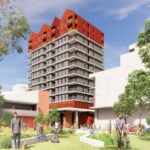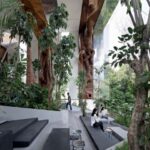Mandragore: Growing a carbon neutral residential tower
It might be just a little bit taller than your average mangrove forest, but it may have the same effect on trapping excess carbon in the atmosphere.
mandragore residential tower is the latest proposal from Paris based architecture studio, rescubika, as an architectural way to reduce carbon emissions from the planet.

GALLERY






A 737 meter-tall building, conceived to inhabit Roosevelt Island in New York City. The design of the mandragore residential tower takes inspiration from the human-like form of the mandrake plant. The sinuous architecture intends to symbolize humankind’s relationship with nature, and serve as a reminder that we must preserve our environment in order to live in symbiosis with the planet.
The project is a response to the “city of tomorrow”, a city that will consider its carbon footprint and achieve carbon neutrality by 2050. To reach this ambitious target, rescubika has designed the tower with the idea of creating a carbon sink. Broadly speaking, a carbon sink is a reservoir that absorbs more CO2 than it releases, effectively reducing carbon from the atmosphere. For buildings, this idea can also be applied by using sustainable materials that can store carbon.
Whilst the final design materials have yet to be confirmed, rescubika has proposed to use wooden materials and various measures to decarbonize the air. These include using passive energies such as an air-ground heat exchanger, which uses underground pipes to help to capture heat from the ground and dissipate heat to the ground. This system provides a warm indoor environment during winter and helps cool the building down during hot summer months.
Designed over 160 floors, the mandragore residential tower concept implements 36 wind turbines, 1600 trees, 24,500 sqm of plant walls, and 7,000 sqm of photovoltaic façades. Thanks to this huge number of plants and shrubs, rescubika proposes a design that absorbs a large amount of carbon and is therefore less polluting for the ecosystem.
Architecturally speaking, this could be the next best step to help the planet, short of us all living in mangrove forests.
Images via rescubika + designboom
Studio Tate has completed a lavish redesign of the 17th floor of a distinctive hexagonal building in Melbourne, ...
Red sculptural interventions define the interior of ARKS’ new flagship store in Bandra West, Mumbai, where Anagram Architects ...
Work is set to begin on a new 12-storey mixed-use affordable housing development in Adelaide’s inner north-west, marking ...
Frame Garden Café, known as Tanatap, represents another prototype in an evolving series of multi-level greenspaces that challenge ...







